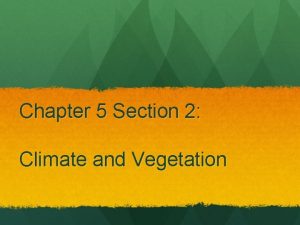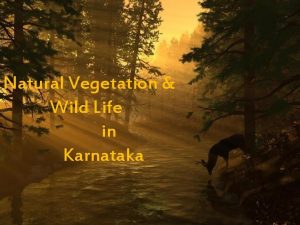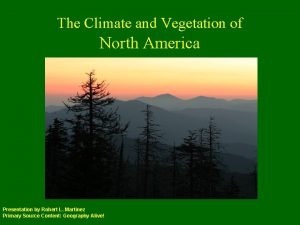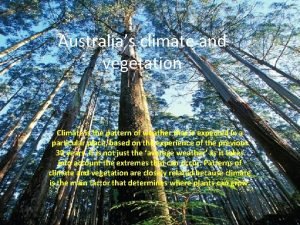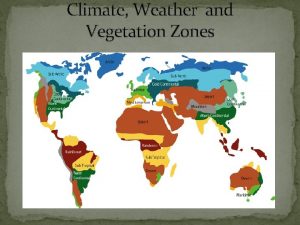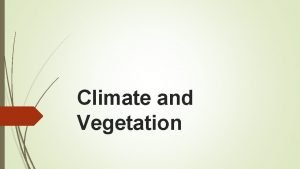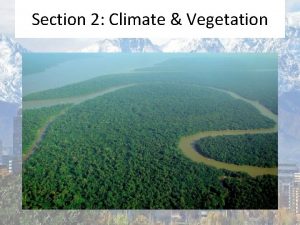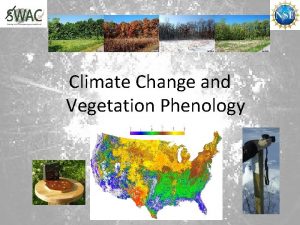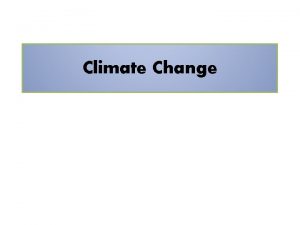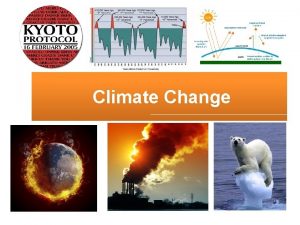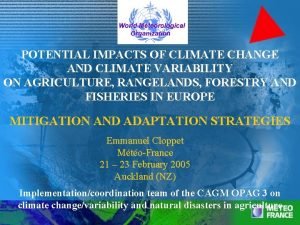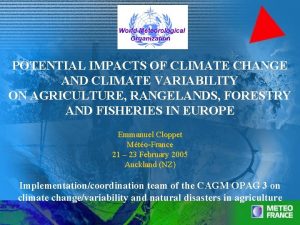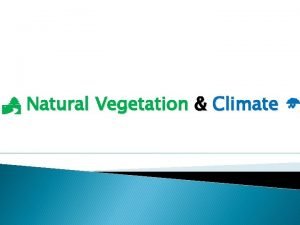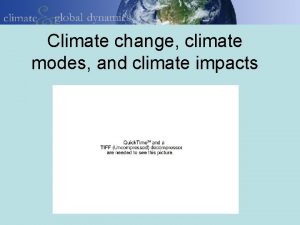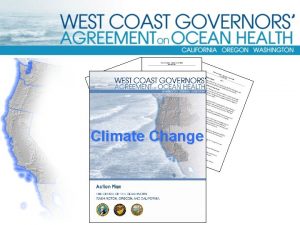Potential Impacts of Climate Change on Vegetation in





















- Slides: 21

Potential Impacts of Climate Change on Vegetation in the Appalachian LCC Patrick Jantz, Tina Cormier, Scott Zolkos, Scott Goetz and the LCCVP Group NASCB July 10, 2014 Missoula, MT Photo credit: Andri Kyrychok

Appalachian LCC

Appalachian LCC

Approach • Summarize existing species distribution model results for the eastern U. S. (Iverson et al. 2008, Mc. Kenney et al. 2011) • Summarize projected climate in terms of historical range of variability for target NPS units • Ecosystem process models to gain insight into the nature of climate change induced stressors • Bioclimatic envelope modeling for major vegetation types • Bioclimatic envelope modeling for individual species

Published species distribution models (Iverson et al. 2008, Mc. Kenney et al. 2011) Decline in habitat richness of 32 key tree species Zolkos et al. in review

Shenandoah Projected Climate • Results are similar for other NPS units

Ecosystem Process Projections

Ecosystem Process Projections

Ecosystem Process Projections • Results are similar for other NPS units

Reference or training data: Field observations of target species or map of vegetation types, e. g. biomes, communities. Probability of presence or suitability estimates Current suitability Future suitability time 1 Predictors: stack of ecologically relevant variables (e. g. , climate, soil type, etc. ). Bioclimatic Envelope Model (aka SDM) Future suitability time 2. . . time n. Estimates and projections: apply models to current or projected conditions

Envelope Modeling for Vegetation Types Our objective is to use bioclimatic envelope models as “ecologically scaled metrics of the extent and nature of projected climate change” (Jackson et al. 2009) in support of vulnerability assessment. Response variable: NPS/USGS vegetation map gridded to 800 m cells represents suitability for vegetation types Predictors: NEXDCP 30 gridded climate, STATSGO soils, potential relative radiation, twi

Cove Forest Current Mapped Current modeled – park only Current modeled – rangewide 2050 modeled – park only 2050 modeled – rangewide

Cove Forest

Species Distributions

Conclusions • Preliminary results from veg. distribution models, ecosystem process models, plus synthesis of existing distribution models point to significant shifts in forest communities as a result of climate change. • Cove Forest models indicate that topoclimates need better representation • Next step to use these results to help identify areas within NPS units where species/communities may persist longest and which may be high management priorities.

Thanks! We acknowledge support from NASA Climate and Biological Response grant NNH 10 ZDA 001 N Photo credit: Andri Kyrychok

Extra

INPUT: Fine scale NPS vegetation map represents ES suitability + INPUT: Bioclimatic variables (e. g. , max temp of warmest month) Use veg classification to calculate %cover in each larger pixel OUTPUT: ES-level %cover/habitat suitability map

Species Level Mapping: Sugar Maple

Recent Historical Trends 10 year moving average of annual minimum temperature

 Climate change 2014 mitigation of climate change
Climate change 2014 mitigation of climate change Impacts of climate change
Impacts of climate change Chapter 15 section 2 climate and vegetation
Chapter 15 section 2 climate and vegetation Name the type of natural vegetation of karnataka
Name the type of natural vegetation of karnataka Canada natural vegetation
Canada natural vegetation Why is the middle east so dry
Why is the middle east so dry North america vegetation zones
North america vegetation zones Australia climate and vegetation
Australia climate and vegetation Climate and vegetation zones
Climate and vegetation zones Describe the characteristics of equatorial climate
Describe the characteristics of equatorial climate ψs
ψs Market potential and forecasting
Market potential and forecasting Refractory period in action potential
Refractory period in action potential Joules per coulomb
Joules per coulomb Chapter 25 electric potential
Chapter 25 electric potential End plate potential
End plate potential Graded potential vs action potential
Graded potential vs action potential Define electric potential and potential difference.
Define electric potential and potential difference. Osmotic potential vs water potential
Osmotic potential vs water potential Electrical potential energy
Electrical potential energy Osmotic potential vs water potential
Osmotic potential vs water potential Axon hillock
Axon hillock


